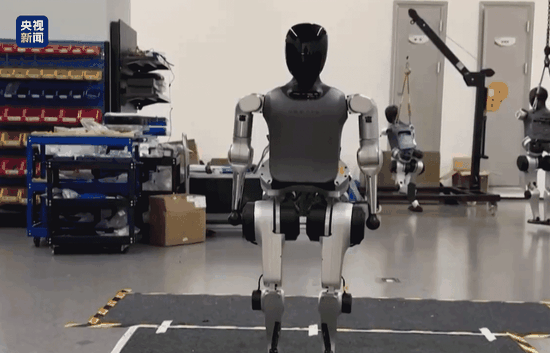From mimicking walks to mastering flips, China's humanoid robots are leaping toward the future
(ECNS) -- A 1.38-meter-tall, 40-kilogram humanoid robot sprinted gracefully through Shenzhen Talent Park, drawing astonished onlookers who quickly captured the scene on their phones.
This was no performance art—rather, it was a running test by Shenzhen-based robotics company EngineAI, marking a significant milestone in China's humanoid robotics development.
Running presents greater technical challenges for robots than walking, requiring rapid actuator responses, increased impact resistance, and precise real-time posture adjustments via high-accuracy sensors to handle uneven terrain.
Just weeks earlier, EngineAI's research team shattered another barrier: their robot performed the world's first humanoid front flip — a seemingly simple maneuver demanding sophisticated integration of mechanical design, control systems, and sensor technology.
“Compared to backflips, front flips require explosive power and micron-level control precision. The key lies in balancing lightweight construction with high-performance components,” explained Ren Guowen, co-founder of EngineAI.
Joint modules, comprising nearly 60% of the robot's weight, became the focal point for optimization. By pioneering dynamic joint technology, the team achieved unprecedented agility while significantly reducing overall mass.
For years, humanoid robots were restricted to stiff, knee-bent gaits due to mechanical and sensor limitations—a challenge EngineAI overcame in October 2024. Their innovative “straight-knee gait,” inspired by human motion patterns, allowed robots to move naturally and fluidly across complex environments.
Yet, the journey to robotic acrobatics was paved with countless crashes.
Yao Qiyuan, co-founder of EngineAI, shared footage of robots falling backward, face-planting, and skidding sideways, metallic joints clanging against the ground.
A significant setback occurred when adding a 500-gram head disturbed the robot's balance, sharply decreasing flip success rates.
Initially, engineers pursued a “perfect landing” strategy demanding millimeter-level precision.
After months of unsuccessful attempts, however, a revelation occurred. “Humans don't freeze mid-air. Why should robots land statically?” said Ren.
Adopting a new approach, the team allowed the robot to take two stabilizing steps after landing, closely mimicking human reflexes.
The robot crouched, gathered momentum, then propelled itself into the air, executed a full flip, and stuck a steady landing.
Following the viral success of humanoid robots performing front flips, a Beijing-based robotics research team recently unveiled humanoid robots capable of performing consecutive backflips.
Zhao Tongyang, CEO of EngineAI, unveiled plans to integrate advanced AI technology this year, broadening potential applications from industrial environments to everyday life.
“Once mobility is perfected, adding intelligence will unlock limitless possibilities,” he stated.
As China's robotics industry accelerates, experts anticipate rapid commercialization. “With maturing technology and quicker industry integration, robots will soon 'sprint' into households,” remarked Bi Yalei, secretary general of the Shenzhen Robotics Association.
From mastering walks to executing flips, China's humanoid robots are boldly leaping toward the future, Bi said. (By Mo Honge)

